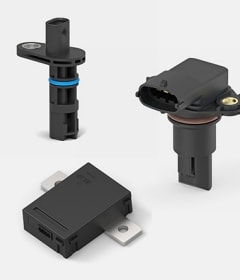
ANTI-FOG SENSOR FAQS
General Fog Prevention
What is a fog prevention strategy?
A fog prevention strategy uses sensors to predict and prevent condensation by monitoring humidity, ambient temperature, and windshield surface temperature. The goal of the strategy is to provide clear visibility by activating the HVAC system before condensation occurs.
Why is an effective fog prevention strategy important?
Driver visibility and focus are critical to achieving vehicle safety. Eliminating the risk of condensation, which can improve visibility and remove the distraction of manually adjusting the HVAC controls, helps Automotive OEMs support safety initiatives.
Can a fog prevention strategy save energy?
The amount of energy required to remove condensation is significantly higher than the energy required to prevent it. This is because it takes more energy to convert liquid water droplets back into vapor than to maintain conditions that prevent condensation from occurring in the first place. In Battery Electric Vehicles (BEVs), these energy savings can translate into extended driving range.
How do you trigger the HVAC system to prevent condensation?
Condensation occurs when the windshield temperature is at or below the dew point temperature. The HVAC should be triggered before this point is reached and should account for variation in cabin humidity and windshield temperature to prevent the formation of condensation. System errors such as sensor accuracy and HVAC response time should also be considered.
What sensor factors contribute to better threshold optimization?
Optimizing the trigger point can further improve the energy efficiency gains. A sensor that has high accuracy, good thermal response and low long-term drift allows the system designer to optimize their trigger point and maintain a more reliable system performance for the life of the vehicle.
How does TE Connectivity meet evolving industry needs for fog prevention solutions?
At TE Connectivity (TE), we continuously innovate to improve our humidity sensor portfolio, leveraging our deep expertise and field-proven solutions. We actively seek partnerships with OEMs and Tier 1 suppliers to develop customized solutions that address evolving industry needs, from optimizing sensor performance to integrating with advanced vehicle systems. Together, we aim to push the boundaries of what’s possible in safety and efficiency.
Anti-Fog Sensors
Where should an anti-fog sensor be installed?
The goal when selecting a mounting location is to choose a location that will give you a repeatable representation of the windshield temperature and cabin humidity measurement. The location should not interfere with the driver’s vision or be affected by localized heat sources (such as heat generated from cameras and other electronics, or directly in the HVAC circulation stream). Historically the area around the rearview mirror has been an ideal choice, however with the advent of cameras mounted in this area, special consideration should be taken to isolate the sensor from the camera’s thermal radiation.
What design features enable the sensor to maintain accuracy?
The humidity chip includes an integrated NTC temperature element that provides the input for an accurate cabin dew point measurement. A separate temperature element is used for a direct windshield temperature measurement and is designed into the product to avoid interference from external heat sources.
What design elements contribute to the sensor's fast response time?
The humidity chip uses an advanced polymer to perform the humidity measurement. The polymer is highly efficient and combined with TE’s electrode configuration provides one of the fastest humidity measurements on the market. This quick response enables fog prevention systems to activate when expected, improving performance and maintaining clear visibility under varying conditions.
Does the sensor itself reduce power consumption?
In addition to the Anti-Fog Sensor's initial low power consumption design, the sensor also has a designed in sleep function which can further reduce power consumption. The sensor will automatically enter sleep mode if it has not been scanned within 4 seconds and wake at the next data request.
What is the sensor's expected lifespan, and how does it handle long-term exposure to automotive environments?
The sensor is engineered for long-term stability and durability, with an expected lifespan of 15 years, for a typical temperature mission profile, aligning with automotive industry expectations.
How has the sensor's performance been validated in the field?
TE's Anti-Fog Sensor has been in use since 2008, providing over 15 years of proven reliability in automotive applications. With millions of units deployed globally, its consistent performance and low ppm failure rate have been validated through extensive field use and design validation, making it a trusted solution for OEMs.
Connect With Us
TE Connectivity’s anti-fog sensor is the trusted choice for OEMs seeking an ultra-compact, high accuracy solution that integrates seamlessly into existing and new vehicle designs.
Backed by over 15 years of proven field experience, our sensors deliver reliable performance with an exceptionally low PPM rate and fast response times for predictive fog prevention. Our customizable solution, combined with our deep technical expertise, global manufacturing scaling, and local support network, is ready to help manufacturers enhance safety, comfort, and system efficiency.


